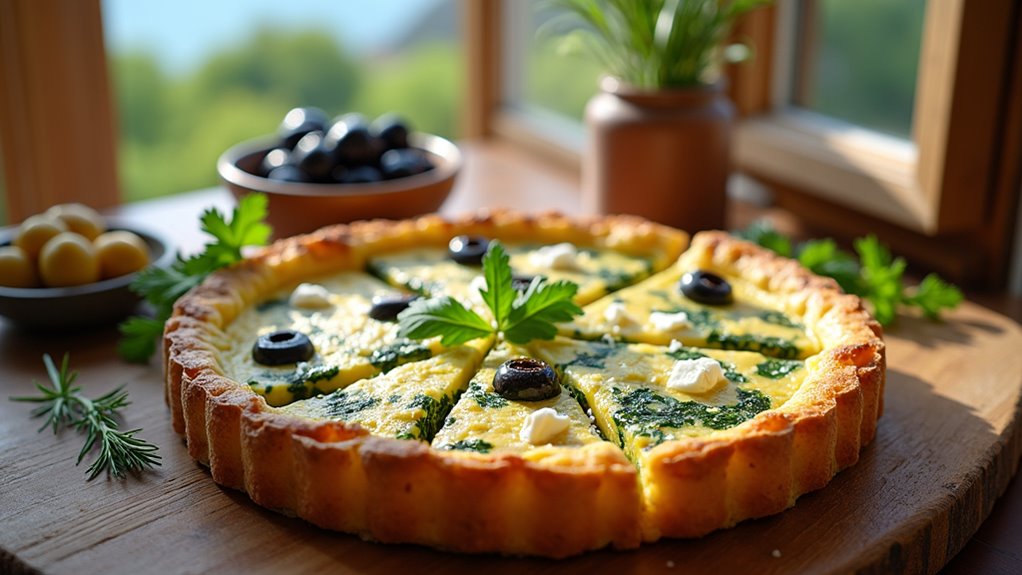A harried dad rushed into my restaurant one morning, desperation in his eyes. “My in-laws are visiting for brunch in an hour, and I promised something ‘impressive’ but easy.” I smiled, scribbling down my Greek frittata recipe on a napkin. “Trust me,” I said, sliding him a taste from our kitchen, “this saved my first catering gig. The feta-olive combo works magic—they’ll think you slaved all morning.” He called later that day: “They asked for the recipe. Twice.”
History & Origin
When exploring the rich culinary landscape of Mediterranean cuisine, the Greek frittata emerges as a fascinating dish with deep historical roots. This egg-based dish originated as a peasant food, transforming leftovers into a nutritious meal.
Greek culinary traditions elevated the frittata by incorporating local ingredients like feta cheese and olives, reflecting the Mediterranean diet’s emphasis on wholesome components. The meatless dish gained popularity during Lent, when Greek Orthodox followers sought vegetable-rich alternatives.
Rooted in simplicity, the frittata represents more than just a meal—it symbolizes resourcefulness, cultural heritage, and the vibrant flavors of Greek cuisine.
Recipe

The Greek Frittata is a delightful Mediterranean-inspired dish that combines the vibrant flavors of the region into a single, satisfying meal. Packed with nutritious ingredients like spinach, tomatoes, and feta cheese, this frittata offers a perfect balance of taste and health.
One of the most appealing aspects of this recipe is its simplicity and versatility. Whether you’re looking for a quick breakfast, a light lunch, or a simple dinner, this gluten-free dish can be prepared in just one pan, making it an ideal choice for home cooks seeking both convenience and flavor.
Ingredients
- 6 large eggs
- 1/2 cup crumbled feta cheese
- 1 cup fresh spinach
- 1/2 cup chopped cherry tomatoes
- 1/4 cup sliced red onions
- 1/4 cup sliced Kalamata olives
- 2 tablespoons olive oil
- Salt and pepper to taste
- Fresh herbs (optional)
Equipment
- 10-inch oven-safe skillet
- Whisk
- Cutting board
- Knife
- Mixing bowl
Instructions
- Preheat oven to 375°F
- Heat olive oil in skillet over medium heat
- Sauté red onions until translucent
- Add spinach and cook until wilted
- Add tomatoes and olives, cook for 2 minutes
- Whisk eggs in separate bowl with salt and pepper
- Pour eggs over vegetables in skillet
- Sprinkle feta cheese on top
- Transfer skillet to oven
- Bake for 15-20 minutes until eggs are set
- Remove from oven and let cool for 5 minutes
- Slice and serve
Nutrition
350 kcal | 8g Carbohydrates | 22g Protein | 26g Fat | 9g Saturated Fat | 4g Polyunsaturated Fat | 11g Monounsaturated Fat | 380mg Cholesterol | 520mg Sodium | 380mg Potassium | 1200 Vitamin A IU | 15mg Vitamin C | 250mg Calcium | 3mg Iron
Cooking Tips
When preparing this frittata, ensure your skillet is oven-safe and use medium heat to prevent burning the vegetables. For added flavor, experiment with different herbs like oregano or dill, and consider using leftover vegetables to customize the dish to your taste preferences.
Serving Suggestions
When serving a Greek frittata, focus on complementary accompaniments that elevate the dish’s Mediterranean flavors. A crisp Greek salad with ripe tomatoes, cucumber, and Kalamata olives provides a refreshing contrast to the rich, eggy frittata.
Consider plating the frittata with toasted whole grain bread or English muffins to create a more substantial meal, and add a side of fresh seasonal fruit or a light yogurt-based tzatziki dip to balance the savory profile.
The versatility of this dish allows for elegant brunch presentations or casual family-style servings, making it adaptable to various dining settings.
Common Mistakes & Troubleshooting
One common mistake when preparing a frittata is overcooking the eggs, which can result in a dry, rubbery texture.
During my early cooking experiments, I once left a frittata in the oven too long, causing the edges to brown excessively and the center to become tough.
To prevent this, use medium heat, watch the cooking time carefully, and remove the frittata from the oven when the center is just set but still slightly jiggly.
A quick tip is to insert a knife near the center – if it comes out clean with minimal liquid, the frittata is perfectly cooked.
Frequently Asked Questions
Can You Put Olives in Frittata?
I love adding olives to frittatas. They bring a delicious salty kick and Mediterranean flair. By chopping them up, I ensure they’re evenly distributed, creating a flavorful and nutritious egg dish that’s perfect for any meal.
Can You Put Feta in a Frittata?
Yes, I can definitely put feta in a frittata! It adds a delightful tangy flavor and creamy texture. I’ll crumble it into small pieces for even distribution, creating a delicious Mediterranean-inspired egg dish that’s both savory and satisfying.
What Is in a Mediterranean Frittata?
A Mediterranean frittata bursts with eggs, feta, and fresh vegetables like spinach and bell peppers. I’ll toss in Kalamata olives and herbs like oregano, creating a vibrant, gluten-free dish that’s packed with Mediterranean flavors.
What Is the Main Difference Between a Quiche and Frittata?
The key difference is that a quiche has a pastry crust and is baked, while I can make a frittata entirely on the stovetop or in the oven, without a crust, using beaten eggs and various ingredients.
Final Thoughts
This Greek frittata isn’t just a meal—it’s a celebration of Mediterranean culinary tradition. By combining simple, fresh ingredients like spinach, tomatoes, and feta, you’re creating more than food; you’re crafting an experience. The beauty of this dish lies in its versatility and nutritional profile.
Whether seeking a quick breakfast, light lunch, or elegant dinner, this frittata delivers. It’s proof that healthy eating can be delicious, simple, and deeply satisfying.
If you enjoyed this Greek-inspired egg dish, be sure to check out our recipe for Pesto Chicken Frittata, which offers a delightful twist on this Mediterranean classic.



